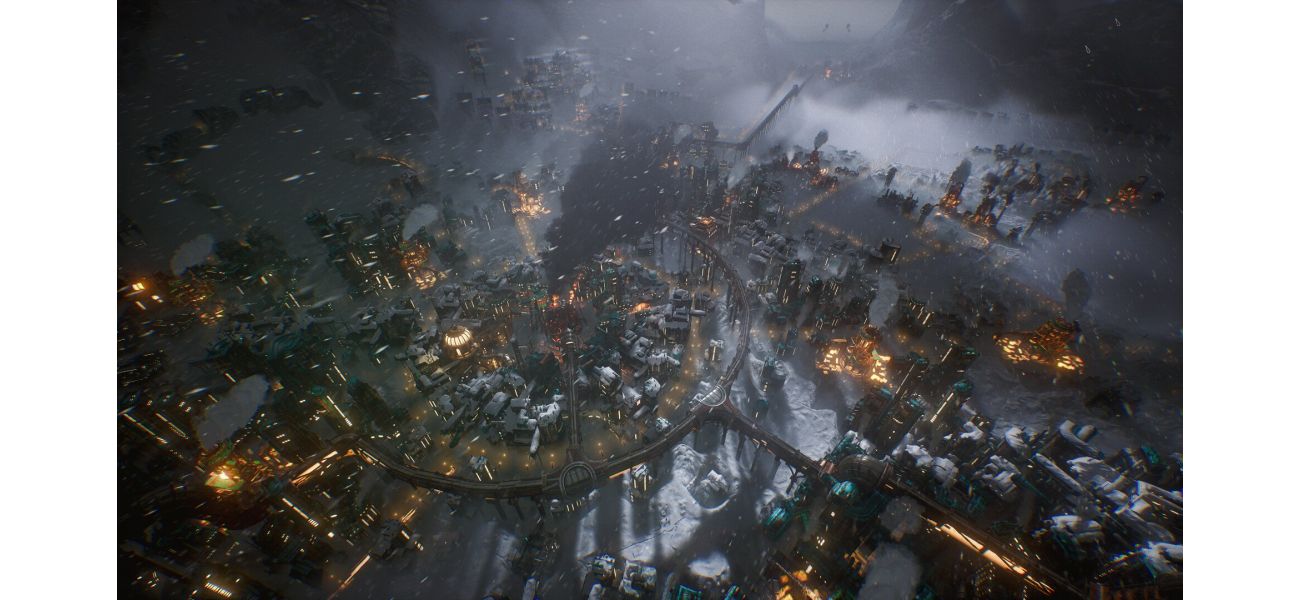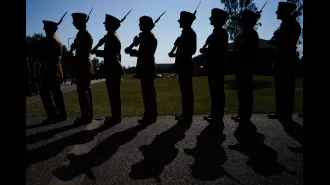The second installment of Frostpunk receives a positive review, with a focus on the theme of the greater good.
"Frostpunk 2 is a thrilling game that combines post-apocalyptic city building and politics, making it a must-play of the year."
September 23rd 2024.

Have you ever wondered what it would be like to make major decisions that could determine the fate of an entire city? Well, that's exactly what you'll be faced with in Frostpunk 2. This post-apocalyptic city builder and political simulator may not sound like the most thrilling premise, but trust me, it's one of the most intense and captivating games of the year.
It's interesting to think about what villains from movies or comic books would do if they actually succeeded in taking over the world. What happens after they defeat the forces of good? Do they get bogged down in mundane tasks like setting tax rates and implementing environmental policies, or do they let chaos and anarchy reign? The Frostpunk series shows us that being in charge of the world means constantly having to make tough decisions and that the end result is all that matters, regardless of your intentions.
In the world of Frostpunk, the Earth has been reduced to a single city, perched atop a glacier where Great Britain once stood. This unique post-apocalyptic setting is based on an alternate history where the eruption of Krakatoa in 1883 triggered a catastrophic ice age that nearly wiped out all of humanity.
As the leader of the last known settlement on Earth, it's your responsibility to keep it functioning. But in order to do so, you must make constant sacrifices. And while the situation in this sequel may seem more stable, since you're now dealing with a larger population, the morality of your decisions becomes even more murky.
The first Frostpunk game was a standout because it not only offered excellent city-building gameplay, but it also had a strong narrative. Unlike other similar games, your choices in Frostpunk made you feel guilty for the innocent lives you had to sacrifice for the greater good. Frostpunk 2 continues this trend, but on a larger scale. Now, your decisions not only affect individuals, but also the entire population.
Thanks to the events of the previous game, humanity has survived and the city of New London is no longer on the brink of disaster, but it's still not completely safe. Just one or two fuel shortages could spell doom for the entire population. However, the central concept remains the same – making difficult decisions for the greater good – but the gameplay in Frostpunk 2 is vastly different from its predecessor.
Your perspective is now more zoomed out, as you're dealing with a larger population. This means you can no longer see individual citizens trudging through the snow or walking the city streets. This change serves a practical purpose, as you're now managing zones of buildings instead of individual structures. But it also serves as a visual metaphor, highlighting how your high-level decisions distance you from the people you're affecting.
In Frostpunk 2, there are no easy decisions. While you still receive feedback from citizens through comments and discussions, most of your interactions with them take place in the council chambers. Here, your plans depend not only on your resource management and research skills, but also on your ability to win over the 100 sitting councillors.
Just like in real life, Frostpunk 2 highlights how politicians can become disconnected from the people they're meant to serve. Instead of being a heroic freedom fighter, you're more like an out-of-touch politician who is completely out of touch with the struggles of the common people.
The city-building aspect of Frostpunk 2 is similar to other games in the genre. You must create zones for housing, industry, and resource production, while also scouting new areas and establishing colonies. But this time, you must also deal with political factions that have their own agendas and demands. Some may ask for you to prioritize certain technologies, while others may push for specific laws that may not be in the best interest of the city.
The political aspect of the game is nuanced, and it's possible to make promises and then find ways to trick factions into not getting what they want. This raises the question of whether authoritarianism is justified in extreme circumstances – a key theme in the Frostpunk series. Some factions may advocate for taking away citizens' rights or neglecting the needs of the people, all in the name of survival. It's up to you to decide how much you're willing to deviate from your original plan in order to do what's right.
Frostpunk 2's story mode takes about 12 hours to complete, but it's more of an extended tutorial than a complex narrative. The real stories are created by your decisions and are illustrated through small vignettes that show the human cost of your policies. The main game mode is the sandbox mode, but it still has objectives to achieve, such as reaching a certain population goal.
Despite the bleak setting and focus on tough decision-making, Frostpunk 2 is a visually stunning game. The zoomed-out view of your city against a backdrop of white snow is strangely beautiful. While there are a few interface issues, overall, it's unobtrusive and allows you to focus on the gameplay.
Some players may be disappointed that Frostpunk 2 feels less personal and more abstract compared to its predecessor, but that's the whole point. In this game, people are reduced to mere statistics, and you must make tough decisions that affect hundreds or even thousands of lives. It's a sobering reminder of the harsh realities of leadership and the sacrifices that must be made for the greater good.
Have you heard about Frostpunk 2? It may not sound like the most thrilling game - a post-apocalyptic city builder and political simulator - but trust me, it's one of the most intense and captivating games of the year. And it's not just about building a city or making political decisions, it's about facing the consequences of those decisions and dealing with the weight of responsibility that comes with ruling the world.
Have you ever wondered what would happen if movie or comic book villains actually succeeded in conquering the world? Would they be concerned with mundane tasks like tax rates and environmental policies, or would they let chaos and anarchy reign? Frostpunk 2 explores this concept, showing us that ruling the world is never easy and the end result is all that matters - regardless of your intentions.
In the world of Frostpunk, humanity has been reduced to a single city, perched on a glacier above the ruins of what was once Great Britain. This unique post-apocalyptic scenario is based on an alternative history where the eruption of Krakatoa in 1883 triggered a catastrophic ice age that almost wiped out humanity. As the leader of the last surviving settlement, it's up to you to make tough decisions and sacrifices to keep the city running.
But in Frostpunk 2, the stakes are even higher. With a larger population to manage, every decision you make has a greater impact and the morality of your choices becomes even more ambiguous. The game challenges you to think about the greater good versus individual lives, and how your actions as a leader can have far-reaching consequences.
The first Frostpunk game was unique in that it combined city-building gameplay with a strong narrative. And Frostpunk 2 continues this trend, making you feel the weight of your decisions and the guilt of sacrificing innocent lives for the sake of the city. But now, as you deal with a larger population, your decisions also depend on the support of 100 council members. The game cleverly highlights the disconnect between politicians and the people they are meant to serve, as you find yourself making decisions that may not align with the needs of the citizens.
Creating and managing zones for housing, industry, and resources is just one aspect of the game. You also have to venture out into the icy wilderness to establish new colonies and keep your city connected through roads and power lines. It's a delicate balancing act, and even the seemingly mundane task of clearing snow to expand your city can become addictive.
But don't mistake Frostpunk 2 for a cozy city-building game. The political aspect adds a layer of complexity and challenges as you navigate relationships with various factions. You must carefully decide which demands to fulfill and which to ignore, as you try to keep the city running smoothly. And sometimes, even when you think you're doing the right thing, you may end up tricking or betraying a faction for your own gain - a reflection of the harsh realities of politics.
The game also raises thought-provoking questions about authoritarianism and whether it can be justified in extreme circumstances. Some factions may push for strict laws and policies that sacrifice individual rights for the greater good, and it's up to you to decide how far you're willing to go to maintain control.
Although the story mode can be completed in about 12 hours, the real stories are created through your decisions in the game. The sandbox mode offers a more open-ended experience, but there are still objectives to achieve, keeping the gameplay focused and engaging.
Despite the bleak setting and serious themes, Frostpunk 2 is visually stunning. The zoomed-out view of your city against the backdrop of the white, frozen landscape is strangely beautiful. And while there may be some minor issues with the user interface, overall it's clean and unobtrusive.
Some players may miss the more personal touch of the first Frostpunk game, but the shift to a larger scale and more abstract perspective is intentional. It emphasizes the idea that in ruling the world, individuals become mere statistics and the weight of your decisions becomes even heavier.
In the end, Frostpunk 2 challenges you to think about the complexities of ruling and the impact of your decisions on the lives of others. It's not a game for the faint-hearted, but it's a thought-provoking and engaging experience that will stay with you long after you've finished playing.
It's interesting to think about what villains from movies or comic books would do if they actually succeeded in taking over the world. What happens after they defeat the forces of good? Do they get bogged down in mundane tasks like setting tax rates and implementing environmental policies, or do they let chaos and anarchy reign? The Frostpunk series shows us that being in charge of the world means constantly having to make tough decisions and that the end result is all that matters, regardless of your intentions.
In the world of Frostpunk, the Earth has been reduced to a single city, perched atop a glacier where Great Britain once stood. This unique post-apocalyptic setting is based on an alternate history where the eruption of Krakatoa in 1883 triggered a catastrophic ice age that nearly wiped out all of humanity.
As the leader of the last known settlement on Earth, it's your responsibility to keep it functioning. But in order to do so, you must make constant sacrifices. And while the situation in this sequel may seem more stable, since you're now dealing with a larger population, the morality of your decisions becomes even more murky.
The first Frostpunk game was a standout because it not only offered excellent city-building gameplay, but it also had a strong narrative. Unlike other similar games, your choices in Frostpunk made you feel guilty for the innocent lives you had to sacrifice for the greater good. Frostpunk 2 continues this trend, but on a larger scale. Now, your decisions not only affect individuals, but also the entire population.
Thanks to the events of the previous game, humanity has survived and the city of New London is no longer on the brink of disaster, but it's still not completely safe. Just one or two fuel shortages could spell doom for the entire population. However, the central concept remains the same – making difficult decisions for the greater good – but the gameplay in Frostpunk 2 is vastly different from its predecessor.
Your perspective is now more zoomed out, as you're dealing with a larger population. This means you can no longer see individual citizens trudging through the snow or walking the city streets. This change serves a practical purpose, as you're now managing zones of buildings instead of individual structures. But it also serves as a visual metaphor, highlighting how your high-level decisions distance you from the people you're affecting.
In Frostpunk 2, there are no easy decisions. While you still receive feedback from citizens through comments and discussions, most of your interactions with them take place in the council chambers. Here, your plans depend not only on your resource management and research skills, but also on your ability to win over the 100 sitting councillors.
Just like in real life, Frostpunk 2 highlights how politicians can become disconnected from the people they're meant to serve. Instead of being a heroic freedom fighter, you're more like an out-of-touch politician who is completely out of touch with the struggles of the common people.
The city-building aspect of Frostpunk 2 is similar to other games in the genre. You must create zones for housing, industry, and resource production, while also scouting new areas and establishing colonies. But this time, you must also deal with political factions that have their own agendas and demands. Some may ask for you to prioritize certain technologies, while others may push for specific laws that may not be in the best interest of the city.
The political aspect of the game is nuanced, and it's possible to make promises and then find ways to trick factions into not getting what they want. This raises the question of whether authoritarianism is justified in extreme circumstances – a key theme in the Frostpunk series. Some factions may advocate for taking away citizens' rights or neglecting the needs of the people, all in the name of survival. It's up to you to decide how much you're willing to deviate from your original plan in order to do what's right.
Frostpunk 2's story mode takes about 12 hours to complete, but it's more of an extended tutorial than a complex narrative. The real stories are created by your decisions and are illustrated through small vignettes that show the human cost of your policies. The main game mode is the sandbox mode, but it still has objectives to achieve, such as reaching a certain population goal.
Despite the bleak setting and focus on tough decision-making, Frostpunk 2 is a visually stunning game. The zoomed-out view of your city against a backdrop of white snow is strangely beautiful. While there are a few interface issues, overall, it's unobtrusive and allows you to focus on the gameplay.
Some players may be disappointed that Frostpunk 2 feels less personal and more abstract compared to its predecessor, but that's the whole point. In this game, people are reduced to mere statistics, and you must make tough decisions that affect hundreds or even thousands of lives. It's a sobering reminder of the harsh realities of leadership and the sacrifices that must be made for the greater good.
Have you heard about Frostpunk 2? It may not sound like the most thrilling game - a post-apocalyptic city builder and political simulator - but trust me, it's one of the most intense and captivating games of the year. And it's not just about building a city or making political decisions, it's about facing the consequences of those decisions and dealing with the weight of responsibility that comes with ruling the world.
Have you ever wondered what would happen if movie or comic book villains actually succeeded in conquering the world? Would they be concerned with mundane tasks like tax rates and environmental policies, or would they let chaos and anarchy reign? Frostpunk 2 explores this concept, showing us that ruling the world is never easy and the end result is all that matters - regardless of your intentions.
In the world of Frostpunk, humanity has been reduced to a single city, perched on a glacier above the ruins of what was once Great Britain. This unique post-apocalyptic scenario is based on an alternative history where the eruption of Krakatoa in 1883 triggered a catastrophic ice age that almost wiped out humanity. As the leader of the last surviving settlement, it's up to you to make tough decisions and sacrifices to keep the city running.
But in Frostpunk 2, the stakes are even higher. With a larger population to manage, every decision you make has a greater impact and the morality of your choices becomes even more ambiguous. The game challenges you to think about the greater good versus individual lives, and how your actions as a leader can have far-reaching consequences.
The first Frostpunk game was unique in that it combined city-building gameplay with a strong narrative. And Frostpunk 2 continues this trend, making you feel the weight of your decisions and the guilt of sacrificing innocent lives for the sake of the city. But now, as you deal with a larger population, your decisions also depend on the support of 100 council members. The game cleverly highlights the disconnect between politicians and the people they are meant to serve, as you find yourself making decisions that may not align with the needs of the citizens.
Creating and managing zones for housing, industry, and resources is just one aspect of the game. You also have to venture out into the icy wilderness to establish new colonies and keep your city connected through roads and power lines. It's a delicate balancing act, and even the seemingly mundane task of clearing snow to expand your city can become addictive.
But don't mistake Frostpunk 2 for a cozy city-building game. The political aspect adds a layer of complexity and challenges as you navigate relationships with various factions. You must carefully decide which demands to fulfill and which to ignore, as you try to keep the city running smoothly. And sometimes, even when you think you're doing the right thing, you may end up tricking or betraying a faction for your own gain - a reflection of the harsh realities of politics.
The game also raises thought-provoking questions about authoritarianism and whether it can be justified in extreme circumstances. Some factions may push for strict laws and policies that sacrifice individual rights for the greater good, and it's up to you to decide how far you're willing to go to maintain control.
Although the story mode can be completed in about 12 hours, the real stories are created through your decisions in the game. The sandbox mode offers a more open-ended experience, but there are still objectives to achieve, keeping the gameplay focused and engaging.
Despite the bleak setting and serious themes, Frostpunk 2 is visually stunning. The zoomed-out view of your city against the backdrop of the white, frozen landscape is strangely beautiful. And while there may be some minor issues with the user interface, overall it's clean and unobtrusive.
Some players may miss the more personal touch of the first Frostpunk game, but the shift to a larger scale and more abstract perspective is intentional. It emphasizes the idea that in ruling the world, individuals become mere statistics and the weight of your decisions becomes even heavier.
In the end, Frostpunk 2 challenges you to think about the complexities of ruling and the impact of your decisions on the lives of others. It's not a game for the faint-hearted, but it's a thought-provoking and engaging experience that will stay with you long after you've finished playing.
[This article has been trending online recently and has been generated with AI. Your feed is customized.]
[Generative AI is experimental.]
0
0
Submit Comment





